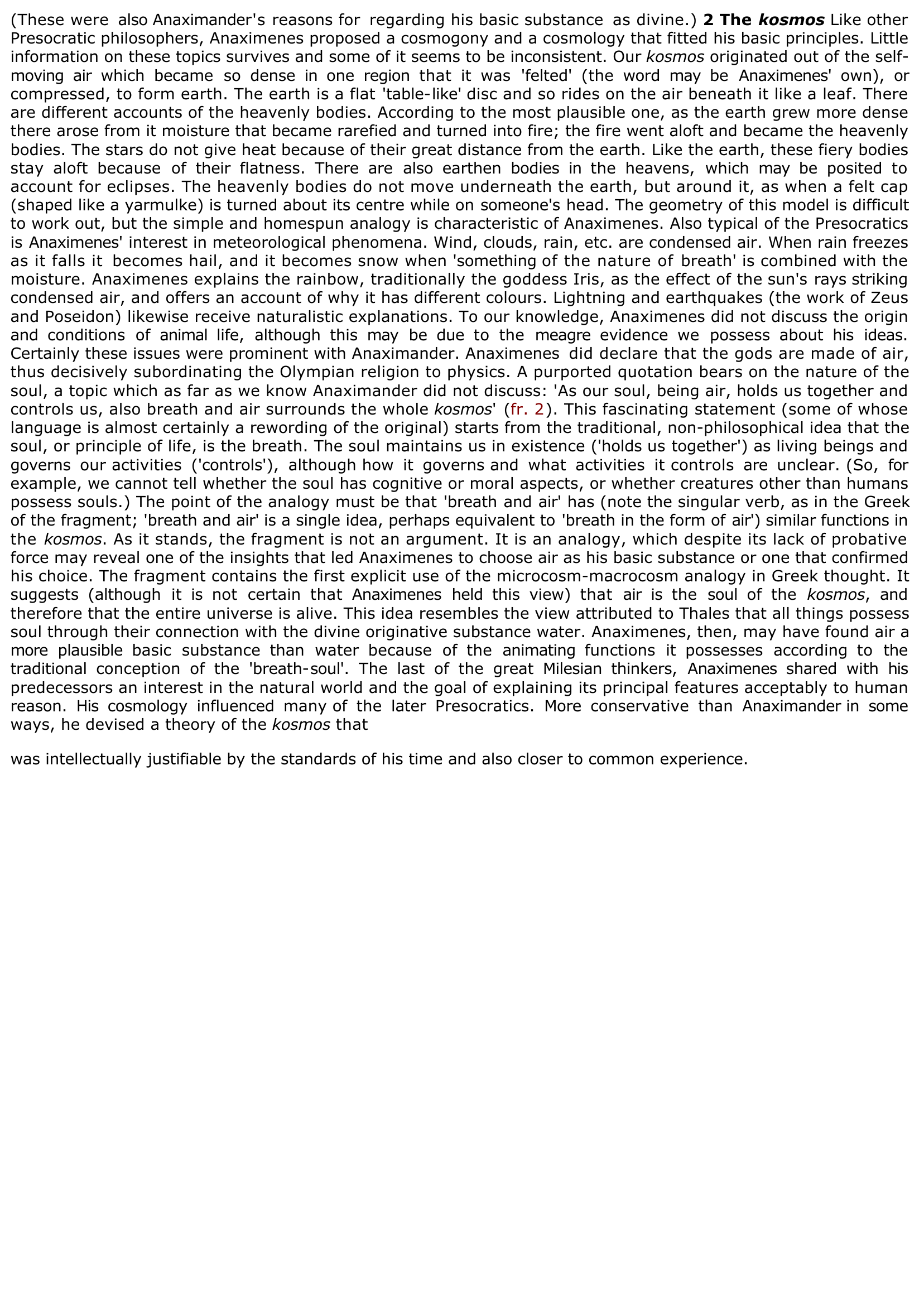Anaximenes
Publié le 17/01/2010

Extrait du document
The Greek philosopher Anaximenes of Miletus followed Anaximander in his philosophical and scientific interests. Only a few words survive from his book, but there is enough other information to give us a picture of his most important theories. Like the other early Presocratic philosophers he was interested in the origin, structure and composition of the universe, as well as the principles on which it operates. Anaximenes held that the primary substance - both the source of everything else and the material out of which it is made - is air. When rarefied and condensed it becomes other materials, such as fire, water and earth. The primordial air is infinite in extent and without beginning or end. It is in motion and divine. Air generated the universe through its motion, and continues to govern it. The human soul is composed of air and it is likely that Anaximenes believed the entire kosmos (world) to be alive, with air functioning as its soul. Like other Presocratics, he proposed theories of the nature of the heavenly bodies and their motions, and of meteorological and other natural phenomena.
«
(These were also Anaximander 's reasons for regarding his basic substance as divine.) 2 The kosmos Like other Presocratic philosophers, Anaximenes proposed a cosmogony and a cosmology that fitted his basic principles.
Littleinformation on these topics survives and some of it seems to be inconsistent.
Our kosmos originated out of the self- moving air which became so dense in one region that it was 'felted' (the word may be Anaximenes' own), or compressed, to form earth.
The earth is a flat 'table -like' disc and so rides on the air beneath it like a leaf.
There are different accounts of the heavenly bodies.
According to the most plausible one, as the earth grew more densethere arose from it moisture that became rarefied and turned into fire; the fire went aloft and became the heavenlybodies.
The stars do not give heat because of their great distance from the earth.
Like the earth, these fiery bodiesstay aloft because of their flatness.
There are also earthen bodies in the heavens, which may be posited toaccount for eclipses.
The heavenly bodies do not move underneath the earth, but around it, as when a felt cap(shaped like a yarmulke) is turned about its centre while on someone's head.
The geometry of this model is difficult to work out, but the simple and homespun analogy is characteristic of Anaximenes.
Also typical of the Presocraticsis Anaximenes' interest in meteorological phenomena.
Wind, clouds, rain, etc.
are condensed air.
When rain freezes as it falls it becomes hail, and it becomes snow when 'something of the nature of breath' is combined with the moisture.
Anaximenes explains the rainbow, traditionally the goddess Iris, as the effect of the sun's rays striking condensed air, and offers an account of why it has different colours.
Lightning and earthquakes (the work of Zeusand Poseidon) likewise receive naturalistic explanations.
To our knowledge, Anaximenes did not discuss the originand conditions of animal life, although this may be due to the meagre evidence we possess about his ideas.Certainly these issues were prominent with Anaximander.
Anaximenes did declare that the gods are made of air,thus decisively subordinating the Olympian religion to physics.
A purported quotation bears on the nature of thesoul, a topic which as far as we know Anaximander did not discuss: 'As our soul, being air, holds us together and controls us, also breath and air surrounds the whole kosmos ' (fr.
2 ).
This fascinating statement (some of whose language is almost certainly a rewording of the original) starts from the traditional, non-philosophical idea that thesoul, or principle of life, is the breath.
The soul maintains us in existence ( 'holds us together' ) as living beings and governs our activities ( 'controls' ), although how it governs and what activities it controls are unclear.
(So, for example, we cannot tell whether the soul has cognitive or moral aspects, or whether creatures other than humanspossess souls.) The point of the analogy must be that 'breath and air' has (note the singular verb, as in the Greek of the fragment; 'breath and air' is a single idea, perhaps equivalent to 'breath in the form of air') similar functions in the kosmos .
As it stands, the fragment is not an argument.
It is an analogy, which despite its lack of probative force may reveal one of the insights that led Anaximenes to choose air as his basic substance or one that confirmedhis choice.
The fragment contains the first explicit use of the microcosm-macrocosm analogy in Greek thought.
Itsuggests (although it is not certain that Anaximenes held this view) that air is the soul of the kosmos , and therefore that the entire universe is alive.
This idea resembles the view attributed to Thales that all things possesssoul through their connection with the divine originative substance water.
Anaximenes, then, may have found air amore plausible basic substance than water because of the animating functions it possesses according to thetraditional conception of the 'breath -soul' .
The last of the great Milesian thinkers, Anaximenes shared with his predecessors an interest in the natural world and the goal of explaining its principal features acceptably to humanreason.
His cosmology influenced many of the later Presocratics.
More conservative than Anaximander in someways, he devised a theory of the kosmos that
was intellectually justifiable by the standards of his time and also closer to common experience..
»
↓↓↓ APERÇU DU DOCUMENT ↓↓↓

































